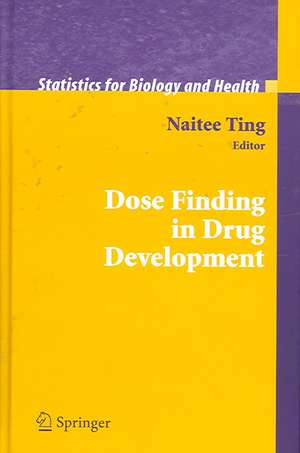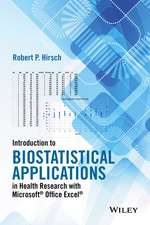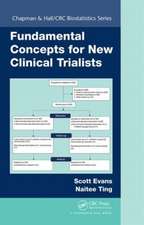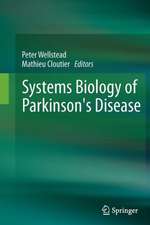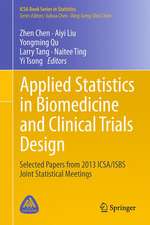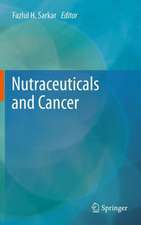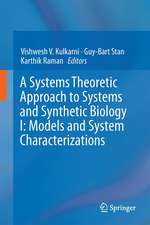Dose Finding in Drug Development: Statistics for Biology and Health
Editat de Naitee Tingen Limba Engleză Hardback – 7 mar 2006
| Toate formatele și edițiile | Preț | Express |
|---|---|---|
| Paperback (1) | 1092.43 lei 43-57 zile | |
| Springer – 23 noi 2010 | 1092.43 lei 43-57 zile | |
| Hardback (1) | 1286.26 lei 43-57 zile | |
| Springer – 7 mar 2006 | 1286.26 lei 43-57 zile |
Din seria Statistics for Biology and Health
- 20%
 Preț: 633.23 lei
Preț: 633.23 lei - 17%
 Preț: 352.01 lei
Preț: 352.01 lei - 20%
 Preț: 758.04 lei
Preț: 758.04 lei - 20%
 Preț: 1379.34 lei
Preț: 1379.34 lei - 18%
 Preț: 1394.84 lei
Preț: 1394.84 lei - 18%
 Preț: 883.59 lei
Preț: 883.59 lei - 5%
 Preț: 843.91 lei
Preț: 843.91 lei -
 Preț: 397.16 lei
Preț: 397.16 lei - 20%
 Preț: 1002.67 lei
Preț: 1002.67 lei - 18%
 Preț: 1395.32 lei
Preț: 1395.32 lei - 5%
 Preț: 1102.10 lei
Preț: 1102.10 lei - 5%
 Preț: 874.83 lei
Preț: 874.83 lei - 15%
 Preț: 657.39 lei
Preț: 657.39 lei - 18%
 Preț: 960.93 lei
Preț: 960.93 lei - 15%
 Preț: 585.90 lei
Preț: 585.90 lei - 5%
 Preț: 852.69 lei
Preț: 852.69 lei - 18%
 Preț: 903.62 lei
Preț: 903.62 lei - 5%
 Preț: 721.40 lei
Preț: 721.40 lei - 15%
 Preț: 653.46 lei
Preț: 653.46 lei - 18%
 Preț: 2114.90 lei
Preț: 2114.90 lei - 18%
 Preț: 1108.99 lei
Preț: 1108.99 lei - 5%
 Preț: 821.39 lei
Preț: 821.39 lei - 5%
 Preț: 849.02 lei
Preț: 849.02 lei - 15%
 Preț: 653.14 lei
Preț: 653.14 lei - 18%
 Preț: 958.56 lei
Preț: 958.56 lei - 5%
 Preț: 722.69 lei
Preț: 722.69 lei - 18%
 Preț: 728.74 lei
Preț: 728.74 lei - 18%
 Preț: 943.22 lei
Preț: 943.22 lei - 5%
 Preț: 1092.43 lei
Preț: 1092.43 lei - 15%
 Preț: 594.21 lei
Preț: 594.21 lei - 5%
 Preț: 377.87 lei
Preț: 377.87 lei - 18%
 Preț: 1124.60 lei
Preț: 1124.60 lei - 18%
 Preț: 1220.12 lei
Preț: 1220.12 lei - 15%
 Preț: 632.98 lei
Preț: 632.98 lei - 18%
 Preț: 1394.84 lei
Preț: 1394.84 lei -
 Preț: 389.11 lei
Preț: 389.11 lei - 18%
 Preț: 959.98 lei
Preț: 959.98 lei
Preț: 1286.26 lei
Preț vechi: 1353.95 lei
-5% Nou
Puncte Express: 1929
Preț estimativ în valută:
246.15€ • 255.53$ • 205.25£
246.15€ • 255.53$ • 205.25£
Carte tipărită la comandă
Livrare economică 24 martie-07 aprilie
Preluare comenzi: 021 569.72.76
Specificații
ISBN-13: 9780387290744
ISBN-10: 0387290745
Pagini: 248
Ilustrații: XIV, 248 p.
Dimensiuni: 155 x 235 x 18 mm
Greutate: 0.49 kg
Ediția:2006
Editura: Springer
Colecția Springer
Seria Statistics for Biology and Health
Locul publicării:New York, NY, United States
ISBN-10: 0387290745
Pagini: 248
Ilustrații: XIV, 248 p.
Dimensiuni: 155 x 235 x 18 mm
Greutate: 0.49 kg
Ediția:2006
Editura: Springer
Colecția Springer
Seria Statistics for Biology and Health
Locul publicării:New York, NY, United States
Public țintă
ResearchCuprins
and New Drug Development Process.- Dose Finding Based on Preclinical Studies.- Dose-Finding Studies in Phase I and Estimation of Maximally Tolerated Dose.- Dose-Finding in Oncology—Nonparametric Methods.- Dose Finding in Oncology—Parametric Methods.- Dose Response: Pharmacokinetic–Pharmacodynamic Approach.- General Considerations in Dose–Response Study Designs.- Clinical Trial Simulation—A Case Study Incorporating Efficacy and Tolerability Dose Response.- Analysis of Dose–Response Studies—Emax Model.- Analysis of Dose–Response Studies—Modeling Approaches.- Multiple Comparison Procedures in Dose Response Studies.- Partitioning Tests in Dose–Response Studies with Binary Outcomes.- Analysis of Dose–Response Relationship Based on Categorical Outcomes.- Power and Sample Size for Dose Response Studies.
Recenzii
From the reviews:
"The book will be of particular interest to statisticians with some pharmaceutical industry experience who find themselves working on phase II dose finding problems. It will also be valuable for clinicians and pharmacokineticists with some statistical background. All chapters in the book are extensively referenced as they each do not pretend to exhaust their subject." Journal of Biopharmaceutical Statistics, Issue #2, 2007
"The book is a collection of chapters contributed by different authors, each addressing a different aspect of the important problem of how to identify appropriate doses of medication during the drug development process … . Consequently the most appropriate audience is statisticians and biostatisticians who desire an overview of the medical and regulatory contexts of the design and analysis of dose response studies … . On the whole the individual chapters are well written, and the book overall is a nice reference … ." (C. A. Fung, Short Book Reviews, Vol. 26 (2), 2006)
"Dose Finding in Drug Development is a contemporary roadmap to the statistical design and analysis of dose-response studies, particularly those in phases II and III of drug development. ...In general, the book is easy to read. ...At roughly $5.71 per chapters, with each chapter authored by between one and three established experts, the book is a high-yield investment of any reader's time and money." (Thomas E. Bradstreet, Journal of the American Statistical Association, Vol. 102, No. 477, 2007)
"The book will be of particular interest to statisticians with some pharmaceutical industry experience who find themselves working on phase II dose finding problems. It will also be valuable for clinicians and pharmacokineticists with some statistical background. All chapters in the book are extensively referenced as they each do not pretend to exhaust their subject." Journal of Biopharmaceutical Statistics, Issue #2, 2007
"The book is a collection of chapters contributed by different authors, each addressing a different aspect of the important problem of how to identify appropriate doses of medication during the drug development process … . Consequently the most appropriate audience is statisticians and biostatisticians who desire an overview of the medical and regulatory contexts of the design and analysis of dose response studies … . On the whole the individual chapters are well written, and the book overall is a nice reference … ." (C. A. Fung, Short Book Reviews, Vol. 26 (2), 2006)
"Dose Finding in Drug Development is a contemporary roadmap to the statistical design and analysis of dose-response studies, particularly those in phases II and III of drug development. ...In general, the book is easy to read. ...At roughly $5.71 per chapters, with each chapter authored by between one and three established experts, the book is a high-yield investment of any reader's time and money." (Thomas E. Bradstreet, Journal of the American Statistical Association, Vol. 102, No. 477, 2007)
Textul de pe ultima copertă
When you go to the pharmacy and fill a prescription, have you ever wondered if the dose of the medication is right for you? Can the dose be too low so that the drug will not work? Can the dose be too high that it may cause some potential problem? How do people learn about dosing information? This book answers some of these questions.
Dosing information on the drug label is based on discussion and agreement between the pharmaceutical manufacturer and the drug regulatory agency. A drug label is a high level summary of results obtained from many scientific experiments. Scientists with biological, chemical, medical, or statistical background working in the pharmaceutical industry designed and executed these experiments to obtain information to help understand the dosing information.
This book introduces the drug development process, the design and analysis of clinical trials. Many of the discussions are based on applications of statistical methods in the design and analysis of dose response studies. Although the book is prepared mainly for statisticians/biostatisticians, it also serves as a useful reference to a variety of professionals working for the pharmaceutical industry. The potential readers include pharmacokienticists, clinical scientists, clinical pharmacologists, pharmacists, project managers, pharmaceutical scientists, clinicians, programmers, data managers, regulatory specialists, and study report writers. This book is also a good reference for professionals working in a drug regulatory environment, for example, the FDA. Scientists and/or reviewers from both U.S. and foreign drug regulatory agencies can benefit greatly from this book. In addition, statistical and medical professionals in academia may find this book helpful in understanding the drug development process and practical concerns in selecting doses for a new drug.
Naitee Ting received his Ph. D. in statistics from Colorado State University in 1987 and joined Pfizer Research right after obtaining his Ph. D. Dr. Ting is currently an Associate Director of Biostatistics in Pfizer Global Research and Development, supporting clinical development of new drugs. He has over 18 years of experiences in designing and analyzing late phase clinical trials. During his tenure at Pfizer, Dr. Ting has published more than 20 statistical papers in peer-reviewed journals and book chapters. He has also taught clinical trials courses at the University of Connecticut and University of Rhode Island.
Dosing information on the drug label is based on discussion and agreement between the pharmaceutical manufacturer and the drug regulatory agency. A drug label is a high level summary of results obtained from many scientific experiments. Scientists with biological, chemical, medical, or statistical background working in the pharmaceutical industry designed and executed these experiments to obtain information to help understand the dosing information.
This book introduces the drug development process, the design and analysis of clinical trials. Many of the discussions are based on applications of statistical methods in the design and analysis of dose response studies. Although the book is prepared mainly for statisticians/biostatisticians, it also serves as a useful reference to a variety of professionals working for the pharmaceutical industry. The potential readers include pharmacokienticists, clinical scientists, clinical pharmacologists, pharmacists, project managers, pharmaceutical scientists, clinicians, programmers, data managers, regulatory specialists, and study report writers. This book is also a good reference for professionals working in a drug regulatory environment, for example, the FDA. Scientists and/or reviewers from both U.S. and foreign drug regulatory agencies can benefit greatly from this book. In addition, statistical and medical professionals in academia may find this book helpful in understanding the drug development process and practical concerns in selecting doses for a new drug.
Naitee Ting received his Ph. D. in statistics from Colorado State University in 1987 and joined Pfizer Research right after obtaining his Ph. D. Dr. Ting is currently an Associate Director of Biostatistics in Pfizer Global Research and Development, supporting clinical development of new drugs. He has over 18 years of experiences in designing and analyzing late phase clinical trials. During his tenure at Pfizer, Dr. Ting has published more than 20 statistical papers in peer-reviewed journals and book chapters. He has also taught clinical trials courses at the University of Connecticut and University of Rhode Island.
Caracteristici
Introduces the drug development process, the design and analysis of clinical trials Presents statistical applications in the design and analysis of dose response studies Examines important procedural steps from a pharmaceutical industry perspective Audience includes pharmacokineticists, clinical pharmacologists, pharmacists, pharmaceutical scientists, clinicians, programmers, data managers, regulatory specialists, and study report writers Includes supplementary material: sn.pub/extras
